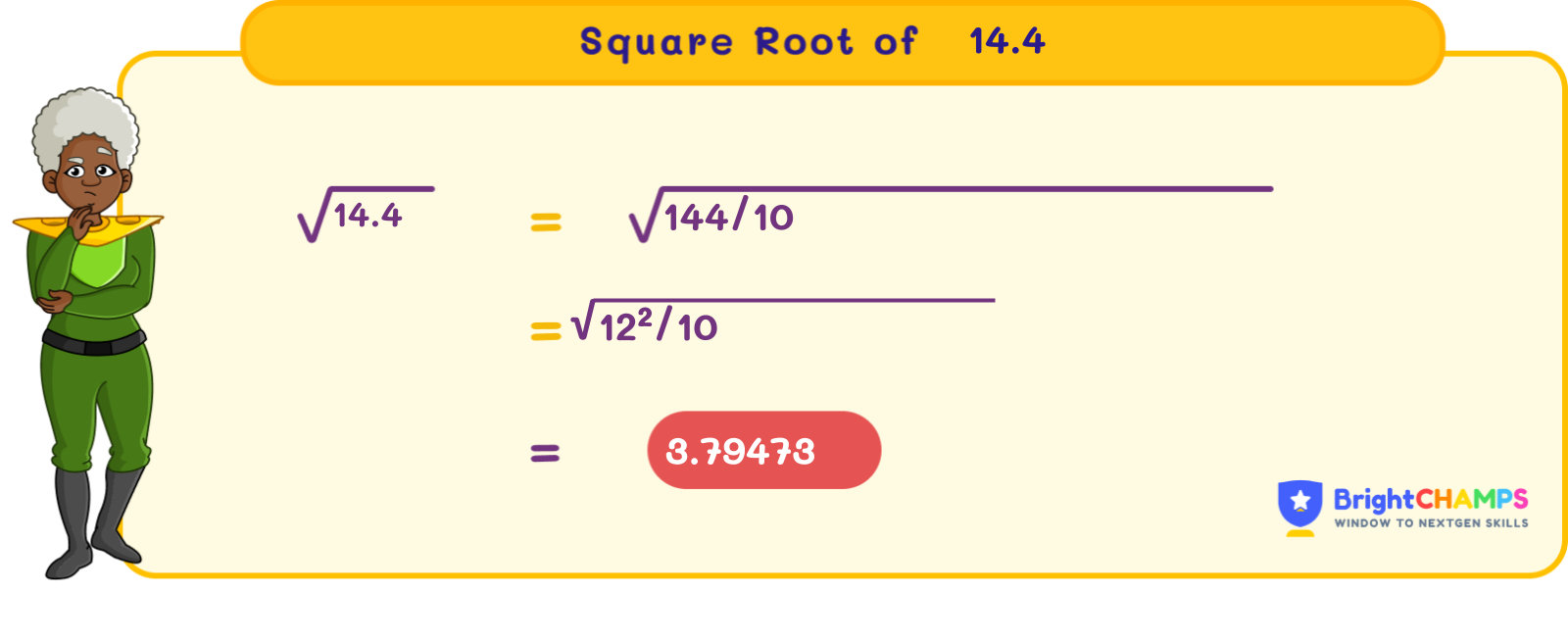![]() Table Of Contents
Table Of Contents

 100 Learners
100 LearnersLast updated on April 7th, 2025

Square Root of 14.4

If a number is multiplied by the same number, the result is a square. The inverse of the square is a square root. The square root is used in fields such as vehicle design, finance, etc. Here, we will discuss the square root of 14.4.
What is the Square Root of 14.4?
The square root is the inverse of the square of a number. 14.4 is not a perfect square. The square root of 14.4 is expressed in both radical and exponential form. In the radical form, it is expressed as √14.4, whereas (14.4)^(1/2) is the exponential form. √14.4 ≈ 3.79473, which is an irrational number because it cannot be expressed in the form of p/q, where p and q are integers and q ≠ 0.
Finding the Square Root of 14.4
The prime factorization method is used for perfect square numbers. However, the prime factorization method is not typically used for non-perfect square numbers, where methods such as the long-division method and approximation method are used. Let us now learn the following methods:
- Prime factorization method
- Long division method
- Approximation method
Square Root of 14.4 by Prime Factorization Method
The product of prime factors is the prime factorization of a number. Now, let us look at how 14.4 can be expressed in terms of its prime factors.
Step 1: Converting 14.4 into a fraction: 14.4 = 144/10 = (12 x 12)/(2 x 5).
Step 2: The prime factorization of 144 is 2 x 2 x 2 x 2 x 3 x 3. The prime factorization of 10 is 2 x 5.
Step 3: Now, we pair the prime factors of the numerator. Since 14.4 is not a perfect square, calculating √14.4 using prime factorization directly involves approximations.
Square Root of 14.4 by Long Division Method
The long division method is particularly used for non-perfect square numbers. In this method, we should check the closest perfect square number to the given number. Let us now learn how to find the square root using the long division method, step by step.
Step 1: To begin with, we need to group the digits in pairs from right to left. In the case of 14.4, consider it as 1440 after multiplying by 100 for ease.
Step 2: Find an integer whose square is less than or equal to 14. Consider n = 3 because 3 x 3 = 9, which is less than 14.
Step 3: Subtract 9 from 14, giving a remainder of 5. Bring down the next pair, making it 540.
Step 4: Double the current quotient (3) to get 6, and use it as the base for the next divisor.
Step 5: Find a digit x such that 6x x x is less than or equal to 540. Using trial, x = 8 works because 68 x 8 = 544.
Step 6: Subtract 544 from 540, resulting in -4, so adjust x to 7, where 67 x 7 = 469.
Step 7: Continue the process to find the quotient to the desired decimal places.
The approximate square root is 3.79473.
Square Root of 14.4 by Approximation Method
The approximation method is another method for finding square roots; it is an easy method to approximate the square root of a given number. Let us learn how to find the square root of 14.4 using the approximation method.
Step 1: Identify the closest perfect squares around 14.4.
The closest smaller perfect square is 9 (√9 = 3), and the closest larger perfect square is 16 (√16 = 4).
Step 2: Using interpolation, approximate between these values: (14.4 - 9) / (16 - 9) = (14.4 - 9) / 7 = 0.7714
Step 3: Approximate the square root: 3 + 0.7714 = 3.7714
Thus, √14.4 ≈ 3.79473 using a more precise calculation.

Common Mistakes and How to Avoid Them in the Square Root of 14.4

Square Root of 14.4 Examples

Problem 1
Can you help Max find the area of a square box if its side length is given as √14.4?

Explanation

Problem 2
A square-shaped field measures 14.4 square meters. What is the length of each side of the field?

Explanation

Problem 3
Calculate √14.4 x 5.

Explanation

Problem 4
What will be the square root of (14 + 0.4)?

Explanation

Problem 5
Find the perimeter of a rectangle if its length ‘l’ is √14.4 units and the width ‘w’ is 10 units.

Explanation


FAQ on Square Root of 14.4
1.What is √14.4 in its simplest form?
2.Calculate the square of 14.4.
3.Is 14.4 a perfect square?
4.Is 14.4 a rational number?
5.What is the square root of 14.4 approximated to two decimal places?
Important Glossaries for the Square Root of 14.4
- Square root: A square root is the inverse of squaring a number. For example, 4² = 16, and the inverse, the square root, is √16 = 4
- Irrational number: An irrational number cannot be expressed as a fraction p/q, where q is not zero and p and q are integers.
- Approximation: The process of finding a value close to the true value, often used when the exact value is difficult to find.
- Long division method: A technique used to find the square root of a non-perfect square number through a series of division steps.
- Decimal: A numerical representation that includes a whole number and a fractional part, separated by a decimal point, such as 7.86.
Explore More algebra
 Previous to Square Root of 14.4
Previous to Square Root of 14.4


Jaskaran Singh Saluja
About the Author
Jaskaran Singh Saluja is a math wizard with nearly three years of experience as a math teacher. His expertise is in algebra, so he can make algebra classes interesting by turning tricky equations into simple puzzles.

Fun Fact
: He loves to play the quiz with kids through algebra to make kids love it.




